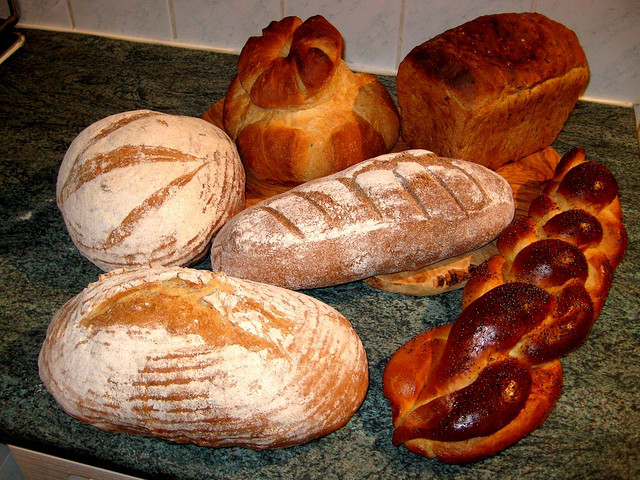Each weekend, you stumble down to the cafeteria or a diner to wash away the previous evening’s sins. You order eggs, bacon and some toast. Grease sits in little pools in the ripples of the bacon. You down three sugary coffees. When you’re done, you wipe the oil on your pants. You feel the food coma coming on. This seems the easiest way to overcome the pain you currently feel, but the food’s bad for you and you’re probably eating too much of it. As students, it’s sometimes tricky to know how to eat well and find the time and money to do so. So every Sunday this semester, nutrition students Anna Richardson and Melissa Danchak will bring you a column on theeyeopener.com about various issues of nutrition and some simple recipes that you can make for cheap.
Gluten-free has become a big trend. Gluten free breads, cookies, pasta, and crackers now make up a big section of your grocery store. But why? Five years ago, you barely would have heard the phrase; now it’s plastered on everything.
Gluten is, put simply, a wheat protein. It is found in wheat and its relatives, and is in thousands of foods we eat – not just the obvious ones like flour, but it can be hidden away in sauces, salad dressings, even meats. Our obsession with wheat has made it quite difficult to avoid – but why would you? Wheat has blessed us with the bounties of pizza, beer, and sweet, sweet cinnamon buns – I’m going to need a good reason to stop eating those.
For a small percentage of the population, gluten is like poison: even just a crumb can set off an inflammatory reaction within the body, causing abdominal pain, fatigue, and a few too many trips to the bathroom. This is celiac disease, where the only treatment is a gluten-free diet for life. Undiagnosed celiac disease can cause a whole host of problems, such as malabsorption of nutrients and intestinal cancer.
But many people never diagnosed with celiac are still following this diet. Celebrities, chefs, and probably your neighbor are also into the gluten-free muffins. Why? Some say it’s just a trend, the newest fad diet. Many people believe they suffer from a type of gluten sensitivity, causing symptoms such as chronic fatigue, abdominal pain, and intestinal irregularities. Many of these people find relief by eliminating gluten – but there is no medical diagnosis for a non-celiac gluten intolerance.
Like any modified diet – there’s a right way and a wrong way. A vegan can never touch an animal product but snack on french fries and bread all day – which isn’t healthy by any standard. A gluten-free diet can easily consist of gluten-free baked goods and pasta, and miss out on a huge part of your body’s nutritional needs.
Chronic fatigue and other vague symptoms can often have a complex cause, and here in North America we love picking out things to vilify. If you suspect gluten is isn’t doing you any favours, give it a try. You could also simply improve your diet to include more fresh, whole foods – that sweet, sweet cinnamon bun isn’t helping your energy levels or digestive health.
Moroccan Chicken with Quinoa
(Adapted from simplygluten-free.com)
An inexpensive recipe naturally free of gluten and full of goodness.
Time: 30 minutes
Serves 6
Ingredients
2 lemons
1 tablespoon paprika
2 teaspoons ground coriander
2 teaspoon ground cumin
1 teaspoon salt
½ teaspoon pepper
6 boneless, skinless chicken thighs or 2-3 chicken breasts
2 tablespoons olive oil
1 large onion, chopped
3 garlic cloves, minced
1 cup dried apricots, roughly chopped
1 cup quinoa or rice
2 cups chicken or vegetable stock
½ cup sliced almonds
½ cup parsley
Directions
Juice one of the lemons and thinly slice the other. Cut the slices into quarters so that you have small pieces of lemon. Set both aside (separately) for later.
In a medium mixing bowl, combine the paprika, coriander, cumin, salt and pepper and stir to combine. Add the chicken pieces and toss to coat.
In a large skillet with a lid over medium high heat, heat the olive oil. Add the chicken and brown, stirring frequently, for 3 -4 minutes. Add the cut up lemon pieces, onion, garlic and apricots. Cook, stirring frequently until the onion softens, about 5 minutes. Add the quinoa/rice and cook, stirring, for 2 minutes. Add the chicken stock and lemon juice. Raise the heat and bring to a boil. Cover the pan, lower the heat to medium low and cook covered for 20 minutes or until the liquid has been absorbed and the quinoa/rice is tender. Remove from the heat and let sit, covered, for 5 minutes.
To serve, put the mixture in a serving bowl, fluff gently with a fork and top with the almonds and parsley leaves.











Leave a Reply